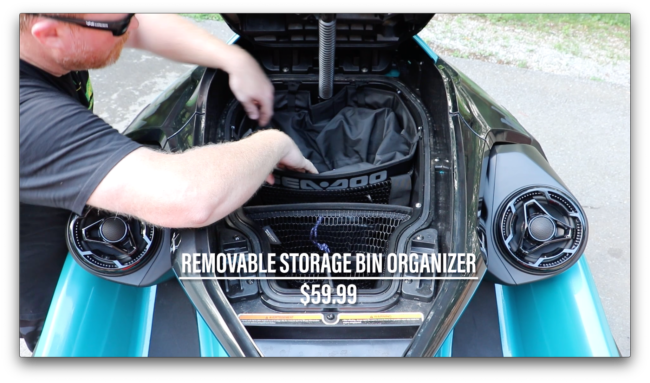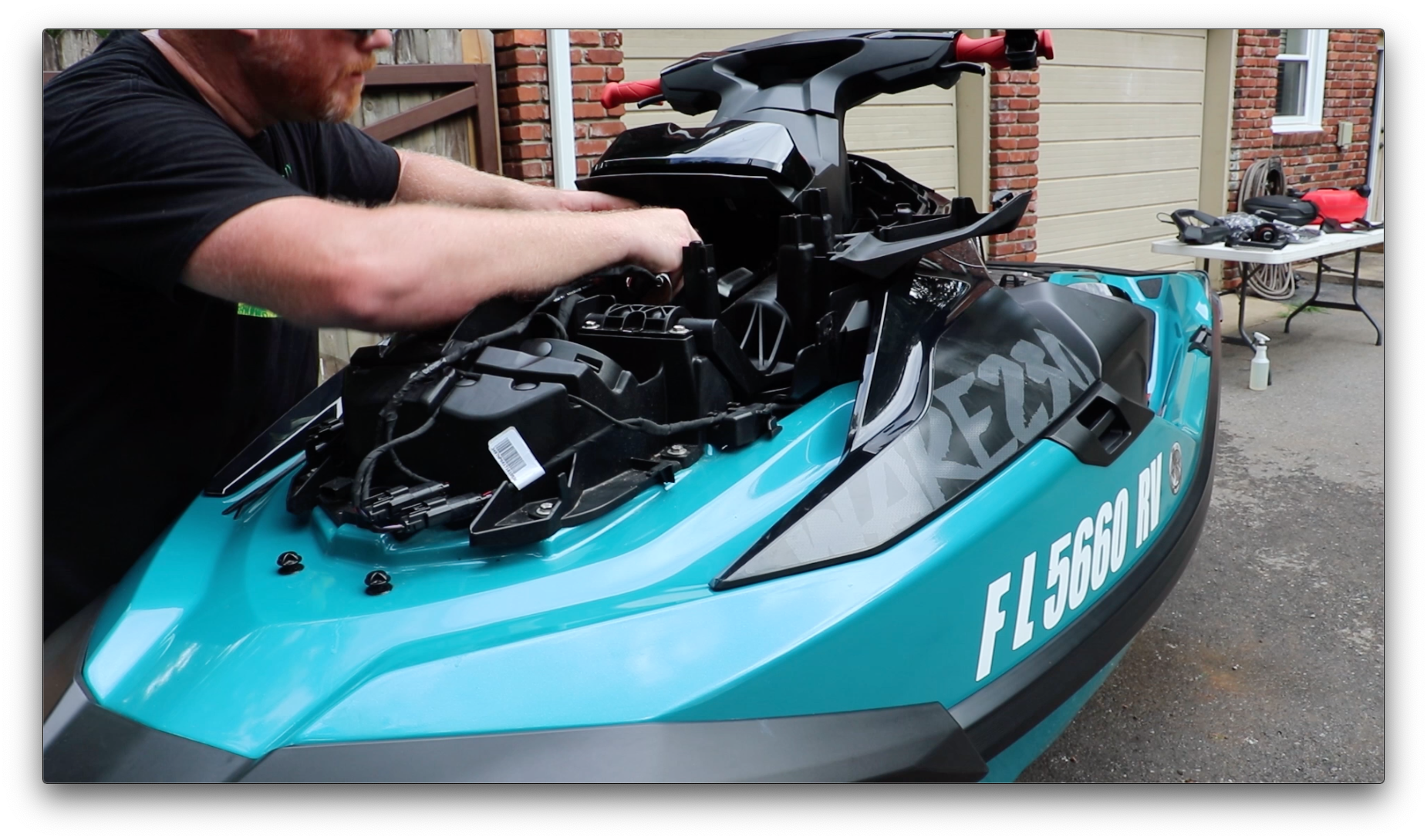
When Sea-Doo introduced the all-new full-sized ST3 platform back in late 2017, one of the key attributes that all of the designers and engineers wanted us to pay close attention to was modularity.
By this, we mean that no matter which model you purchase – whether it be a base-model GTX 155, a race-ready RXT-X 300, an ocean-fairing Fish Pro, or even our brand new 2019 Wake Pro 230 – the ST3 platform allows you to easily customize and equip your Sea-Doo any way you want.
Thanks to several unique features integrated into the 3-seater runabout’s design, any of the full-sized Sea-Doos can be quickly and easily equipped with a king’s ransom of additional gadgets and creature comforts that elevates your time spent on the water to a whole new level of fun and excitement.
Prior to picking up our 2019 Wake Pro 230, we made sure to include the BRP Audio-Premium System. Sea-Doo’s Bluetooth-operated sound system pumps out crisp, clear sound through dual 100-watt driver-directed speakers all through your smartphone or mobile device. Although a $650 option on the order form, it’s well worth the cost of admission, particularly as you’ll pay $949.99 if you choose to upgrade your Sea-Doo at a later date.
Equally, as part of the Wakesports package, the Wake Pro comes equipped with the side-mounted wakeboard rack, spring-loaded folding swim step and of course, the LinQ Retractable Ski Pylon.
But knowing we wanted to plus our Wake Pro even more, we began flipping through the hundreds of options available through Sea-Doo Parts & Accessories’ catalog – and we definitely were NOT disappointed.

The first item on our list was the USB port. Priced at $109.99, the USB Port pigtails directly into the existing factory wiring harness to provide a socket within the Sea-Doo’s standard waterproof cell phone case; meaning you can charge your phone while you ride! Beyond that, the USB port accepts chargers for GoPro cameras, GPS’ or other devices.
Installing the USB port is surprisingly easy and can be done in less than an hour.

As is with ALL work to be done on your Sea-Doo, begin by disconnecting the negative terminal from the battery. Next, we popped out the factory rubber seal plugging the hole for the USB port in the glove box. Then we move the tilt steering up to its highest locking position and open up the 27-gallon center storage bin.
At the front of the bin, you’ll see two 10mm self-tapping screws. Remove these to remove the front hood, which will slide forward easily, without any tugging or pulling.
Beneath the hood, you’ll see the electrical steering harness assembly. This controls the dashboard and Intelligent Throttle Controls in the steering system.
Next, the decorative covers above the side mirrors need to be removed. A single 10mm cap screw holds each down. When removed, the cover will slide outward at an angle. These can be snug, but don’t pull too hard or you’ll snap off the cover’s locating tab.

Before you can remove the Storage Bin Console And Mirror Support, the front deflector is removed using a torx socket. A third hex screw at the front, two cap screws at the mirrors and six snapping tabs secure the storage bin console down. Once you get all those, the console’s lid will be free to remove.
With the console’s cover off, it’s easy to see how the USB Port’s two-piece loom is installed. We began by inserting the USB’s plug into the hole and feeding the loom all the way through, finally squeezing the rubber-lined USB port into the pre-drilled hole in the glove box.
 Next, we wired the second loom to the main harness, interrupting the connection between the console loom and the main harness per Sea-Doo’s instructions. Thankfully, each socket can only be connected to its appropriate partner, so there’s no chance of getting crossed up.
Next, we wired the second loom to the main harness, interrupting the connection between the console loom and the main harness per Sea-Doo’s instructions. Thankfully, each socket can only be connected to its appropriate partner, so there’s no chance of getting crossed up.
We traced the existing harness with our USB loom up and over the engine ventilation assembly, connecting the terminals and securing down the relay as instructed. Finally, we threaded the loom between the front harness and the glove box to not pinch or interfere with the tilt steering, and smartly zip-tied everything down.
Lastly, wanting to double check our handiwork, we reconnected the battery, snapped on our lanyard, tapped the “Start” button. Eureka! The green “charging” icon lit up on the phone without a hiccup. Now we just need to retrace our steps and put our Wake Pro back together.
But we weren’t done yet! We had ordered one of Sea-Doo’s Storage Bin and Removable Storage Bin Organizers as well. Like the USB Port, the Storage Bin Organizer is another really nice item comes included on the top-of-the-line, fully-loaded GTX Limited models but are available as add-ons for the other models.
Installing the Storage Bin Organizer required three self-tapping Philips head screws, but the Removable Storage Bin Organizer simply sets into 4 slots molded into the Central Storage Bin. The large cargo net organizer features a pull string closure and backpack-like straps to allow you to carry your baggage with you as you go ashore. Mesh-lined drains at the bottom also ensure that wet items won’t mildew if left unattended for too long.
One item our Wake Pro 230 didn’t come with were the Ergolock knee pads. When equipped from the factory, two small holes are drilled into each body panel to accommodate the pads’ two locating nipples. Since we’re not terribly excited with the idea of drilling into our brand new Sea-Doo, we opted to simply cut these foam protrusions off, peel off the seals from the 3M double-sided tape, and attach the knee pads accordingly. Obviously, you’ll want to adhere them to a freshly cleaned surface so you can get the best seal as possible.
Feeling pretty good with ourselves thus far, we attached the Wake Pro wakeboard rack to the lower hinge and snapped it into the locking perch above the bond line. The wakeboard rack features padded surfaces, and two rubber sheathed bungies that snap down to keep your wakeboard or skate in place even in turbulent conditions.
Next, came time to install the LinQ Retractable Ski Pylon. A very cool addition to all 2018-and-up full-sized runabouts was the inclusion of the Ski Pylon port, meaning a 155-horsepower GTX or supercharged RXT could be converted into a wakeboard-towing watercraft in a matter of seconds. The pylon’s forward arms require removing the back seat to be installed, but once they snap into place and lock into the ski tower, the seat can be reinstalled with no trouble.
And finally, we decided to go for broke, and load up our Wake Pro with not just the LinQ Fuel Caddy but the LinQ Bag for some added storage and fuel capacity. We’re certain won’t be towing any rafters behind us with these two items stacked up as they are, but the stackability is a great added feature that Sea-Doo designed into the fuel caddy.
Of course, the LinQ system has quickly become one of our favorite features on the new Sea-Doos: those of you who subscribe to this YouTube channel or are daily readers of The Watercraft Journal would have seen us riding last year’s 2018 RXT-X 300 with Sea-Doo’s new 20-liter LinQ cooler. Built sturdy and equal to some of the most expensive coolers available today, the LinQ cooler attaches to the pop-up cleats, which can be collapsed flat when not in use.

Now full loaded and equipped, we set out for a great day out on the water aboard our 2019 Wake Pro 230. Not only did we no longer have to worry about running our phone’s battery down while we listened to music or checked the weather; but we had plenty of extra fuel to get us home if we strayed too far. We really like how tidy the new organizers keep our Sea-Doo’s storage bin, and make accessing items like sunscreen or a bottle of water so easy.
The best part of it all is that these new accessories can be added to ANY of the new full-sized Sea-Doos sharing the ST3 platform. Whether you’re looking for extra comfort, added range or better accessibility, Sea-Doo’s Parts & Accessories was our one-stop-shop.







































